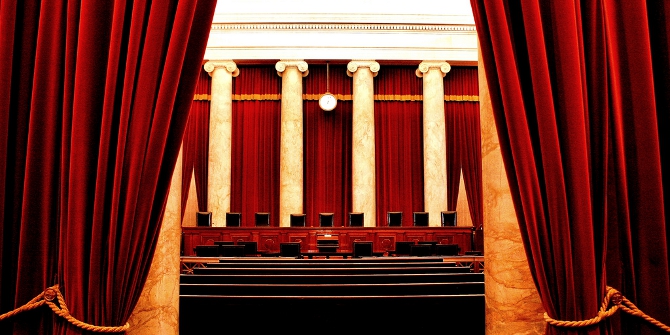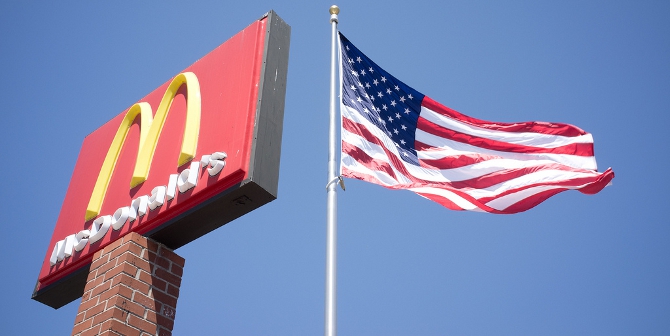 The death late last week of Supreme Court Justice Antonin Scalia has further complicated the 2016 presidential race and threatened to bring even more gridlock to Washington DC with Republican Senate leaders pledging not to confirm any nominee sent to them by President Obama to replace Scalia. Lauren Bell looks at the battle that Obama administration now faces in getting a nominee confirmed, but also argues that a protracted nomination fight might end up working against the Republican Party in an election year.
The death late last week of Supreme Court Justice Antonin Scalia has further complicated the 2016 presidential race and threatened to bring even more gridlock to Washington DC with Republican Senate leaders pledging not to confirm any nominee sent to them by President Obama to replace Scalia. Lauren Bell looks at the battle that Obama administration now faces in getting a nominee confirmed, but also argues that a protracted nomination fight might end up working against the Republican Party in an election year.
Justice Antonin Scalia, who died suddenly at the age of 79 on Saturday, was the most outspoken and visible member of the conservative bloc of justices on the US Supreme Court. At a time when politics in America are more polarized than they have been in decades, it is hard to imagine a more significant turning point for the Court and for the direction of public policy than his death. There have already been several analyses of the possibilities for what happens now.
Scalia was appointed in 1986 to replace Justice William Rehnquist, who in turn had been nominated to fill the vacancy left by retiring Chief Justice Warren Burger. Although he became a flashpoint for liberal interest groups during his three decades on the high court, Scalia’s nomination faced little opposition during the Senate’s confirmation process; his nomination was unanimously approved both by the Senate Judiciary Committee and by the full US Senate.
The same will not be true for the nominee to succeed him.
Making a Nomination
At the outset, it is important to note that there is plenty of time for a nomination to the Supreme Court to clear the US Senate. Nominations to the US Supreme Court historically have taken between two and four months for the Senate to process. Even contentious nominations, like Robert Bork’s in 1987 and Clarence Thomas’s in 1991, took 114 and 99 days, respectively, for the Senate to dispatch.
So, there is no reason for President Barack Obama, who has nearly 11 full months left in his administration, to forego making a nomination. It’s likely he’ll do it quickly, and smart money is on a nominee of impeccable educational, legal, judicial, and personal credentials.
Under ordinary circumstances, President Obama would be looking to replace Justice Scalia—the intellectual center of the conservative bloc on the Supreme Court—with someone who would shift the liberal voting bloc significantly to the left and anchor it there for decades to come. That would argue for appointing someone like Sri Srinivasan (age 48) or California Attorney General Kamala Harris (age 51) who, once confirmed, could remain on the court for a quarter century. Indeed, the New York Times’ first cut at potential nominees reads like a short list of the country’s young and liberal legal elite. And Srinivasan was widely predicted to be the next nominee after his unanimous confirmation to the District of Columbia Circuit Court of Appeals just three years ago.
But the current political climate may favor a safer choice—perhaps someone older (and therefore less likely to stay on the Court for more than a decade or so) and more moderate than the President might prefer under ordinary circumstances. As this argument goes, the President won’t want to give his political opponents any reason to delay or prevent the confirmation of his nominee, so he’ll forego some of the traits he might prefer in order to minimize potential flash points of conflict with the Senate. If he opts for this route, some prospects might include Circuit Court Judges Merrick Garland or Diane Wood.
The Confirmation Process
No matter who gets the nod, the Obama Administration is going to have to work very hard to get his nominee confirmed, even though the calendar suggests that there should be plenty of time to do so. That’s because it’s clear that Republicans currently have no intention of allowing President Obama to replace Justice Scalia.
Normally, once a nomination is received from the White House, it is referred to the Senate Judiciary Committee, which begins its own investigations into the suitability of the nominee, holds public hearings with the nominee, and then forwards the nomination to the full Senate for debate and a confirmation vote. Both parties have investigatory staff on the Judiciary Committee, and the Democrats will begin their work immediately. Barring any unforeseen disqualifier in the nominee’s background, the Democrats will be ready to hold hearings within a few weeks.
If the Republicans begin this process at all, which is unlikely at the outset, they’ll drag it out as long as possible, while trying to turn the public to their view—articulated by Republican Senate Majority Leader Mitch McConnell (KY) just hours after Scalia’s death—that President Obama should not have made a nomination at all, but should have allowed the next President to make the appointment. The Republicans will justify this position with references to the “Thurmond Rule,” which has typically described the difficulty that lifetime appointments to the federal bench face in the last six months of a presidential term, but which they will claim means that the President is not entitled to make an appointment in his final year in office.
In short, Republicans have made it clear that they intend to do whatever they can to avoid allowing President Obama a third appointee to the US Supreme Court.

A Risky Strategy
This is a risky strategy. Supreme Court nominations are highly salient political events. A flat-out refusal to confirm—or even to hold hearings on—a highly-qualified nominee to the Supreme Court is a gamble for any Senate majority, but in this instance, the consequences are much farther reaching than most conflicts between Congress and the President. Furthermore, Republicans have less to gain—and possibly far more to lose—than it might appear at first glance if they refuse to confirm an Obama-nominated replacement.
At the Supreme Court, Justice Scalia’s death means that any cases that were already heard in which he was part of a five-member majority will now be resolved as 4-4 ties, which means that the lower court’s decision stands. Although this will result in decisions that conservatives prefer on such issues as President Obama’s executive actions on immigration, it is likely to guarantee conservative losses in the already-argued cases on redistricting and the soon-to-be-argued cases that continue to push back against the Affordable Care Act’s contraceptive coverage mandate—to name a few examples.
The Court can operate this way indefinitely. On cases still pending, it could insist on rehearing them once a ninth justice is confirmed, but if the justices expect the vacancy to go unfilled for a year or more, they may simply conclude that leaving the lower courts’ decisions intact is the only way to keep their docket from becoming unmanageable. This will mean that conflicts between the circuits will stay unresolved, allowing the interpretation of the law to vary from place to place. And, since a quick glance at the makeup of the federal appeals courts indicates that Democrat presidents appointed a majority of the federal appellate bench, it is not clear that allowing the lower court decisions to stand will mean any less-liberal decisions than what the Court would announce with an Obama-appointed replacement for Justice Scalia. Linda Hirshman at The Washington Post covered this well here. Moreover, since Justice Anthony Kennedy already often sides with the liberal bloc on matters involving privacy and civil rights, Republicans and conservatives who oppose seating another Obama appointee are not likely to gain any ground on those issues by refusing to confirm the nominee.
On the legislative side, Senate Republicans’ refusal to process an Obama nominee will galvanize the left, which has been waiting for the opportunity to replace Justice Scalia for 30 years. As a Republican lobbyist friend of mine noted, if Republicans refuse to act on an obviously well-qualified nominee, Democrats in the Senate will refuse to move any other item of pending business. Washington, he told me, will simply shut down. Thus, if the Republicans refuse to act on President Obama’s nomination, it will be the Democrats who will ultimately control what other parts of the Republican legislative agenda will move in the remainder of the 114th Congress.
In the meantime, the 2016 electoral map makes it a fight for Republicans to retain control of the Senate this Fall. Many vulnerable senators are hoping for a Republican presidential nominee who will energize the party and bring large numbers of rank-and-file Republicans to the polls. It’s not clear who that person might be at this stage of the presidential nominating process. But it is guaranteed that every Democrat challenging one of the vulnerable Senate Republicans will make their refusal to act on a nomination to the Supreme Court a major campaign issue.
Finally, with the Democrats poised to nominate either Hillary Clinton or Bernie Sanders, the prospects for a less-liberal nominee to the Court in the event that a Democrat wins the White House are practically zero. The Senate’s strategy of blanket opposition to seating an Obama appointment only makes sense in the event that a Republican wins the White House in 2016—which current polling suggests is going to be challenging (although polling at this stage is fraught with uncertainty). Senate Republicans and their conservative supporters are going to have some difficult decisions to make if it appears come autumn that the Democrats are nearly certain to retain the presidency.
The Bottom Line
Despite the immediate analyses of what will happen next and the Republicans’ declarations that no Obama nominee will be confirmed this year, it’s hard to know how all of this will play out. The decision for the President is relatively easy—there is no reason he should not make a nomination. But the calculus for Republicans in the Senate is actually fairly complicated. A year is a long time to avoid action on a nomination to the Supreme Court. The confluence of who the nominee is, the dynamics of the 2016 elections, and the tenor of the Court’s decisions in the absence of Justice Scalia all will undoubtedly play a role in the outcome of what is shaping up to be a historic battle over a seat on the Supreme Court.
Please read our comments policy before commenting.
Note: This article gives the views of the author, and not the position of USAPP – American Politics and Policy, nor the London School of Economics.
Shortened URL for this post: http://bit.ly/1KSnkKE
_________________________________
 Lauren C. Bell – Randolph-Macon College
Lauren C. Bell – Randolph-Macon College
Lauren C. Bell is Professor of Political Science and Dean of Academic Affairs at Randolph-Macon College in Ashland, Virginia. She is the author of Filibustering in the US Senate (Cambria Press: 2011) and Warring Factions: Interest Groups, Money, and the New Politics of Senate Confirmation (The Ohio State University Press: 2002). She served as a United States Supreme Court Fellow during 2006-07, and was an American Political Science Association Congressional Fellow on the US Senate Committee on the Judiciary from November 1997 until August 1998.






